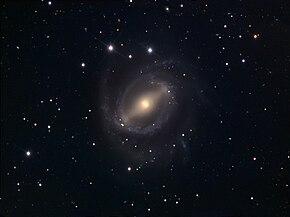| NGC 5850 | |
|---|---|
 | |
| Observation data (J2000 epoch) | |
| Constellation | Virgo |
| Right ascension | 15h 07m 08s |
| Declination | +01° 32′ 39″ |
| Heliocentric radial velocity | 2 545 ± 1 km/s |
| Distance | 131.5 ± 9.2 Mly (40.33 ± 2.83 Mpc) |
| Apparent magnitude (B) | 11.5 |
| Surface brightness | 23 mag/arcsec2 |
| Other designations | |
| PGC 53979, UGC 9715, IRAS 15045+0144 | |
References: List of NGC objects (5001-6000) | |
NGC 5850 is a barred spiral galaxy in the constellation Virgo. Its speed relative to the cosmic microwave background is 2,735 ± 13 km/s,[1] which corresponds to a Hubble distance of 40.3 ± 2.8 Mpc (~131 million ly).[2] NGC 5850 was discovered by German-British astronomer William Herschel in 1786.[3]
Characteristics
[edit]The luminosity class of NGC 5850 is II and it has a broad HI1 line.[4] It is also classified a LINER galaxy; a galaxy whose nucleus presents an emission spectrum characterized by broad lines of weakly ionized atoms.[5][6]
To date, seven non-redshift measurements yield a distance of 18.7 ± 1.75 Mpc (~61 million ly), which is far outside the Hubble distance values.[7] Note that it is with the average value of independent measurements, when they exist, that the NASA/IPAC database calculates the diameter of a galaxy and that consequently the diameter of NGC 5850 could be approximately 58.7 kpc (~191,000 ly) if we used the Hubble distance to calculate it.[8]
Morphology
[edit]NGC 5850 was used by Gérard de Vaucouleurs as a galaxy of morphological type SB(r)b in his galaxy atlas.[9][10] It is classified as a prototype double-barred system early-type spiral galaxy by other studies as well.[11][12]
In 2002, Eskridge, Frogel and Pogge published a paper, describing the morphology of 205 closely spaced spiral galaxies. The observations were carried out in the H band of infrared and in the B band (blue). According to Eskridge and his colleagues, NGC 5850 is a spiral galaxy of type SB(r)ab in the B band and type SB(r)0/a in the H band. The isophotes of the outer bulb are almost circular. The nucleus appears elliptical. The bulb is crossed by a very long bar with ansae at its end. The bar is inclined at 60 degrees to the interior bulb. A complete inner ring is formed at the end of the bar and beyond there is a faint spiral structure. The spiral arms appear to form an incomplete outern pseudo-ring.[13] One of these spiral arms of NGC 5850 appears broken, likely caused by an interaction with a north-west object.[14]
Possible galaxy pair?
[edit]
NGC 5850 is close to its neighbor, NGC 5846. However, the distance between them is exactly 40 million light-years. Although they not a physical pair, it is possible that the two galaxies might have experienced a high-speed encounter around 200 million years ago.[15]
Supernova
[edit]One supernova has been observed in NGC 5850: SN 1987B. It was discovered by Robert Evans on 24 February 1987 lying 71" west and 145" south of the nucleus, shining at magnitude 15.[16] The spectral analysis indicates that it was a non-conventional type II supernova.[17]
See also
[edit]References
[edit]- ^ "NGC 5850 and 5846 in Virgo". www.jthommes.com. Retrieved 2024-04-16.
- ^ "NGC 5850". www.phys.ttu.edu. Retrieved 2024-04-16.
- ^ "Celestial Atlas entry for NGC 5850". cseligman.com. Retrieved 2024-04-16.
- ^ a b info@noirlab.edu. "NGC 5850". www.noirlab.edu. Retrieved 2024-04-16.
- ^ "NGC 5850 - LINER-type Active Galactic Nucleus". simbad.u-strasbg.fr. Retrieved 2024-08-08.
- ^ Bremer, M.; Scharwächter, J.; Eckart, A.; Valencia-S, M.; Zuther, J.; Combes, F.; Garcia-Burillo, S.; Fischer, S. (2013-10-01). "What produces the extended LINER-type emission in the NUGA galaxy NGC 5850?". Astronomy & Astrophysics. 558: A34. doi:10.1051/0004-6361/201322009. ISSN 0004-6361.
- ^ "NASA/IPAC Extragalactic Database". Results for NGC 5850. Retrieved 27 July 2024.
- ^ "NED Query Results for NGC 5850". ned.ipac.caltech.edu. Retrieved 2024-08-08.
- ^ "NGC 5850". kudzu.astr.ua.edu. Retrieved 2024-08-08.
- ^ "Gérard de Vaucouleurs' Atlas of Galaxies". cseligman.com. Retrieved 2024-08-08.
- ^ Bremer, M.; Scharwächter, J.; Eckart, A.; Zuther, J.; Fischer, S.; Valencias-S., M.; Combes, F.; Garcia-Burillo, S. (2013-05-08), The Central 3 kpc of NGC 5850, arXiv:1305.1802
- ^ Buta, R.; Crocker, D. A. (1993-04-01). "Metric Characteristics of Nuclear Rings and Related Features in Spiral Galaxies". The Astronomical Journal. 105: 1344. Bibcode:1993AJ....105.1344B. doi:10.1086/116514. ISSN 0004-6256.
- ^ Eskridge, Paul B.; Frogel, Jay A.; Pogge, Richard W.; Quillen, Alice C.; Berlind, Andreas A.; Davies, Roger L.; DePoy, D. L.; Gilbert, Karoline M.; Houdashelt, Mark L.; Kuchinski, Leslie E.; Ramirez, Solange V.; Sellgren, K.; Stutz, Amelia; Terndrup, Donald M.; Tiede, Glenn P. (November 2002). "Near-Infrared and Optical Morphology of Spiral Galaxies". The Astrophysical Journal Supplement Series. 143 (1): 73–111. arXiv:astro-ph/0206320. Bibcode:2002ApJS..143...73E. doi:10.1086/342340.
- ^ Prieto, Mercedes; Gottesman, S. T.; Aguerri, Jose-Alfonso L.; Varela, Antonia-Maria (October 1997). "Structural Components of NGC 5850". The Astronomical Journal. 114: 1413. Bibcode:1997AJ....114.1413P. doi:10.1086/118573. ISSN 0004-6256.
- ^ Higdon, James L.; Buta, Ronald J.; Purcell, Guy B. (1998-01-01). "An Optical and H i Study of NGC 5850: Victim of a High-Speed Encounter?". The Astronomical Journal. 115 (1): 80–104. Bibcode:1998AJ....115...80H. doi:10.1086/300193. ISSN 0004-6256.
- ^ Transient Name Server entry for SN 1987B. Retrieved 27 July 2024.
- ^ Tsvetkov, D. Y. (1 April 1989). "Observations of Supernovae 1987B and 1987F". Soviet Astronomy Letters. 15: 129. Bibcode:1989SvAL...15..129T.
Further bibliography
[edit]- Aguerri, J. A. L.; Hunter, J. H.; Prieto, M.; Varela, A. M.; Gottesman, S. T.; Muñoz-Tuñón, C. (July 2001). "An hydrodynamical model of the barred galaxy NGC 5850". Astronomy & Astrophysics. 373 (3): 786–795. Bibcode:2001A&A...373..786A. doi:10.1051/0004-6361:20010557.
External links
[edit]- NGC 5850 at SIMBAD
- NGC 5850 on WikiSky: DSS2, SDSS, GALEX, IRAS, Hydrogen α, X-Ray, Astrophoto, Sky Map, Articles and images